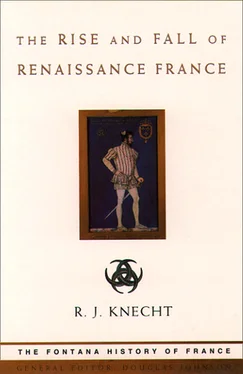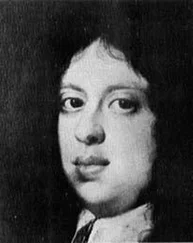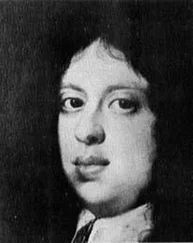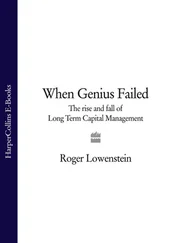After the battle, Francis was taken to the Certosa at Pavia and allowed to write to his mother. ‘All is lost’, he said, ‘save my honour and my life.’ He asked Louise to take care of his children and allow free passage to a messenger whom he was sending to the emperor in Spain. In his letter, Francis appealed to Charles’s magnanimity: by accepting a ransom, he said, Charles would turn his prisoner into a lifelong friend.
The emperor was in Madrid when he received news of his victory on 10 March. He instructed the viceroy of Naples to treat Francis well and to give Louise frequent news of him. The king was, in fact, well treated. He was imprisoned at first in the castle of Pizzighettone, near Cremona, where he remained for nearly three months in the custody of a Spanish captain called Fernando de Alarçon. He was allowed companions, visitors and physical exercise. Montmorency, who shared the king’s captivity, kept his sister Marguerite informed about his health. She urged Francis to stop fasting and sent him the Epistles of St Paul to read. On 18 May he was taken to Genoa, where a fleet of Spanish galleys waited to carry him off to Naples. The prospect terrified Francis, for Naples had the reputation among Frenchmen of being a graveyard. He begged Lannoy to take him instead to Spain, where he hoped to win over the emperor by exercising his charm. The viceroy agreed on condition that French galleys were placed at his disposal. This was duly arranged, and on 19 June Francis landed at Barcelona to a tumultuous welcome. He attended mass in the cathedral and hundreds of sick people came to be touched by him. The king was then taken by sea to Tarragona, where he was nearly killed by a stray bullet as he looked out of a castle window. At the end of June he was moved to Valencia, then to an agreeable Moorish villa at Benisanó.
In the meantime, Montmorency carried three requests from Francis to the emperor in Toledo. The first was for a safe-conduct for the king’s sister Marguerite d’Angoulême to come to Spain as a peace negotiator; the second was for Francis to be brought nearer to the peace table so that he might be more easily consulted; and the third was for a truce to last as long as the talks. All three requests were conceded. At the end of July, Francis was taken to Madrid. His journey, which lasted three weeks, was like a royal progress. At Guadalajara he was lavishly entertained by the duke of Infantado, a leading Spanish grandee; at Alcalá de Henares he visited the university recently founded by Cardinal Jimenez de Cisneros. In Madrid, where he arrived on 11 August, the king was given a room in the Alcázar, which stood on the site of the present royal palace.
The regency of Louise of Savoy
Francis’s captivity lasted just over a year, until 17 March 1526. In his absence France was governed by his mother from the abbey of Saint-Just, near Lyon, assisted by Duprat and by Robertet. Their first task was to provide for the kingdom’s defence. Pavia had not ended the war. France continued to be threatened with invasion for several months, mainly from England. ‘Now is the time’, Henry VIII wrote, ‘for the emperor and myself to devise means of getting full satisfaction from France. Not an hour is to be lost.’ He sent an embassy to Spain with proposals for the dismemberment of France. Henry hoped to be crowned in Paris and to recover all that was his ‘by just title of inheritance’. At the very least, he expected to acquire Normandy or Picardy and Boulogne.
Henry assessed the situation correctly: France had been largely denuded of troops, armaments and supplies in the interest of Francis’s Italian campaign. Such troops as remained in the north were unpaid and lived off the countryside, striking terror in villages and even in the suburbs of Paris. In the south the situation was less critical, as remnants of the royal army drifted back across the Alps. In April, Albany’s troops returned home by sea almost intact. But the regent could only pay some of them; the rest she sent north to swell the marauding bands. A joint invasion by Henry VIII and Charles V would almost certainly have brought the kingdom to its knees; but Henry failed to get the co-operation of Charles, who had to cope with many urgent problems in various corners of Europe. His troops in Italy were unpaid and mutinous, if they had not already deserted. In Germany the Peasants’ War was threatening the very fabric of society, while further east the Turkish threat loomed large. The Sultan Suleiman, having conquered Rhodes in 1522, was preparing to attack Hungary whose king, Louis II, was Charles V’s brother-in-law.
In providing for the defence of France, Louise of Savoy concentrated her efforts on Burgundy. She posted lookouts along the River Saône and sent the comte de Guise to inspect the province’s fortifications. However, in June 1525 her cousin Margaret of Savoy, governor of the Netherlands, renewed the truce neutralizing the frontier dividing the two Burgundies. In the north, Louise relied on help from the parlement. It purchased and sent grain to towns in Picardy and persuaded the Parisian authorities to send arms and ammunition.
Perhaps the most important task facing the regent was to maintain the king’s authority. Some people believed that the regency should be exercised by the king’s nearest adult male kinsman and an attempt was apparently made to put the duc de Vendôme in Louise’s place, but he refused to act in a way likely to divide the kingdom. In March 1525 the parlement assured Louise of its support, but it was keen to reverse the trend towards a more absolute, less consultative, monarchy.
On 23 March the parlement set up a commission to draw up remonstrances for presentation to the regent. Normally, remonstrances were concerned with a particular piece of legislation, but the commissioners chose to examine a wide range of royal policies. They saw the hand of God in the misfortunes that had befallen the kingdom. Penitence and prayer were needed to put matters right, but also measures to root out heresy. Here the parlement was tilting at Marguerite d’Angoulême’s protection of the Cercle de Meaux and at royal interference with the Berquin trial. The parlement also called for the annulment of the Concordat with the Holy See and for a return to the Pragmatic Sanction. It objected to the government’s use of évocations whereby lawsuits were referred to the Grand conseil , which was under the king’s immediate influence. Another area of concern was the fiscal administration. The parlement believed that fiscal officials were thieves and that public money was being wasted. It deplored alienations of the royal demesne regardless of the ‘fundamental law’ that forbade the practice.
When the regent received the remonstrances on 10 April she described them as ‘to the honour of God, exaltation of the faith, and very useful and necessary to the good of the king and commonwealth’. She explained that the Concordat could be revoked only by the king, but promised to satisfy the parlement’s other demands. However, Louise never again spoke about the remonstrances, and only in respect of heresy did she go some way towards meeting the parlement’s wishes. Recent disturbances at Meaux had alarmed the parlement. Bishop Briçonnet was ordered to set up a tribunal comprising two parlementaires and two theologians to try heresy cases. Its competence, which was at first limited to his diocese, was soon extended to include all dioceses within the parlement’s ressort or area of jurisdiction, in effect removing heresy cases from the episcopal courts which had traditionally judged them. The parlement also wanted the new court to try bishops suspected of heresy, but this required papal consent. On 29 April, Louise asked Clement VII for the necessary rescript, which he duly conceded. As the new judges thus exercised papal jurisdiction, they became known as the juges délégués (delegated judges). An appeals procedure was set up from them to the parlement, which consequently achieved overall control of heresy cases.
Читать дальше












